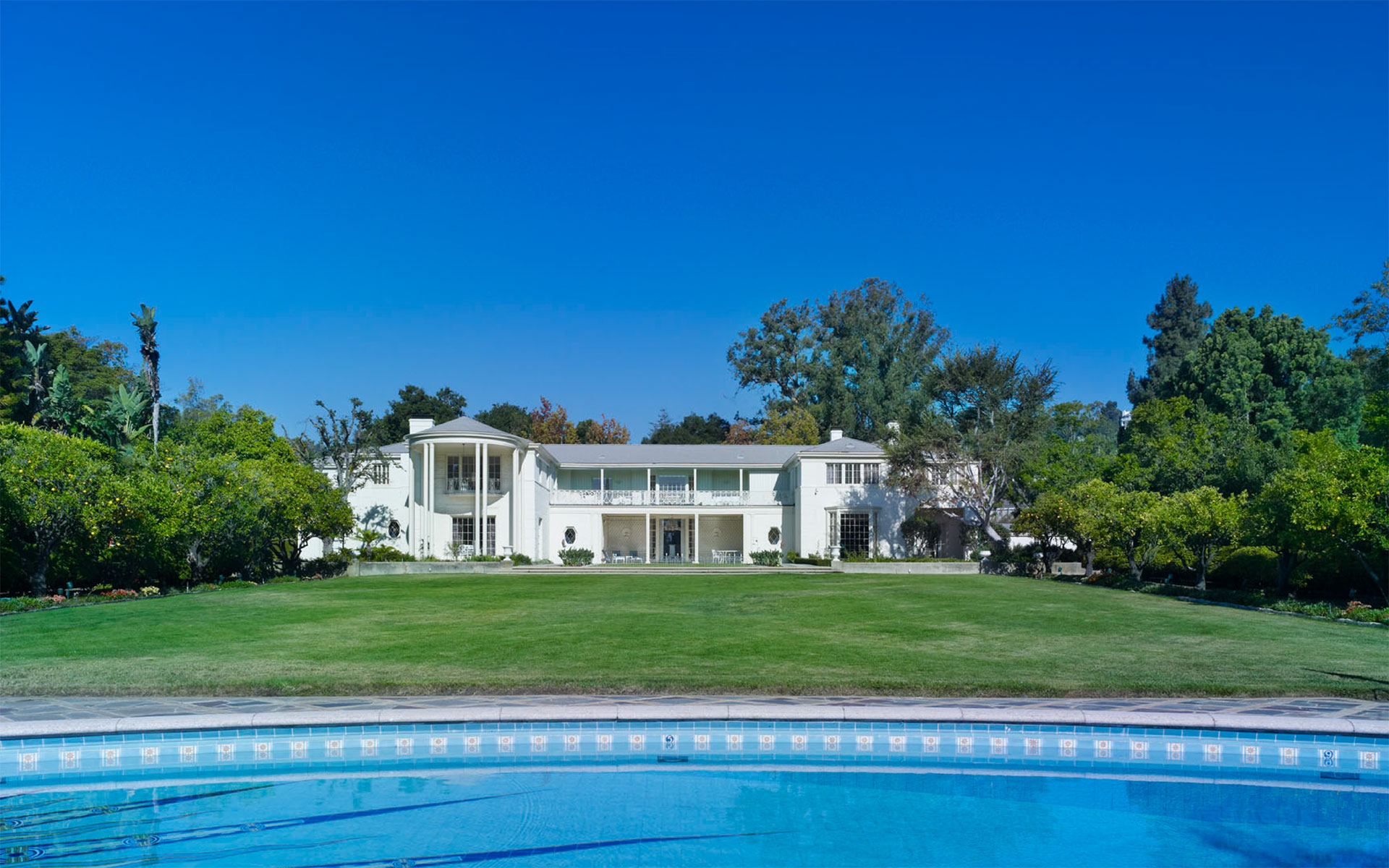
Holmby Hills
“Holmby Hills” is a fanciful variant on the place-name Holdenby, the small English hamlet where 19th century architect Arthur Letts, Sr. was born in 1862. Letts was an entrepreneur of the first order who initially made his fortune by transforming a bankrupt Los Angeles dry goods business into The Broadway department store empire. Letts went on to purchase 400 acres of prime west Los Angeles real estate at $100 an acre.
Letts’ vision was to create a neighborhood of grand estates, a project which would later be christened “The Ultimate in Residential Estate Development.” Among the first mansions built here in the late 1920s was the lavish, Gothic-Tudor-style home of the founder’s son, Arthur Letts, Jr. now forever burned into the American consciousness as Hef’s fabled Playboy Mansion.
From the beginning, Holmby Hills seemed destined for mythic status. The development straddles Sunset Boulevard, located east of Westwood, west of Beverly Hills, and southeast of Bel Air. The community is bordered on the south by Comstock Avenue, on the west by Beverly Glen Boulevard, with North Carolwood Drive and Brooklawn Drive as its eastern border, and Brooklawn Drive curving to form its northernmost tip.
After the sudden death of Letts, Sr. in 1923, his son-in-law Harold Janss took the reins and carried out the grandeur of Letts’ original plan. The community was zoned for large lots up to 4 acres. Electric and telephone lines were buried beneath the wide, tree-lined streets to create the impression of a pastoral, pre-industrial paradise. Privacy, security and elegant seclusion attracted the burgeoning film industry’s elite, and encouraged them to live out their fantasies. In the 1950s Walt Disney built his dream-house in Holmby Hills, highlighted by his miniature live steam railroad, complete with 2,615 feet of track and a 90-foot tunnel. Celebs from Hollywood’s Golden Age nestled in the lush development, making neighbors of notables Frank Sinatra, Jean Harlow, Judy Garland, Lana Turner, Humphrey Bogart and Lauren Bacall, Gary Cooper, Lucille Ball, Bing Crosby, Dean Martin, Sammy Davis, Jr., and Jack Benny. By the 1960s, these luminaries were joined by Nat King Cole, Elvis Presley, Marilyn Monroe, Sonny and Cher, and Lloyd and Dorothy Bridges, who raised their sons Jeff and Beau in Holmby Hills. More recently, Betsy Bloomingdale, followed by Tom Ford, called a mansion on Delfern Drive home, followed by television mogul Aaron Spelling, and television host Ellen DeGeneres. In 2020, Kylie Jenner joined the area’s stellar guest-book, expanding the Kardashian dynasty beyond Calabasas and Hidden Hills.
But by far the most decadent resident was Playboy publisher, Hugh Hefner and his Playboy Mansion West located at 10236 Charing Cross Road (the original mansion being located in Chicago). The 21,987-square-foot hideaway designed by Arthur R. Kelly in 1927 in 1974 became the venue for Hef’s open-ended celebration of the good life at its most hedonistic, including annual Midsummer Night’s Dream parties and Celebrity Poker Tournaments where scores of A-listers including Bill Cosby, Linda Lovelace, John Belushi, James Caan and Paris Hilton were regulars. For decades, the star-studded revelry spilled out from the fabled grotto, sauna, bathhouse, hot tub and swimming pool with swim-up bar to the multiple party rooms fitted with stages, stripper poles, go-go cages, dance-floor, cushioned performance platforms, and floor-to-ceiling mirrors for optimum viewing. The refurbished mansion now is protected from demolition by the City of Los Angeles, under a permanent protection covenant.
Down the street from the Playboy Mansion is Owlwood, the 12,000-square-foot Italian Revival-style mansion designed in 1936 by Robert D. Farquhar, a Los Angeles architect whose other projects included the Pentagon and Beverly Hills High School. The 10-acre estate once owned by Tony Curtis, then Sonny and Cher, sold for $88 million in 2021.
The story of Holmby Hills takes on a sharp poignancy due to the legacy of architect Paul R. Williams, who designed the Jay Paley and Max Azria estates as well as the iconic structure at 111 North Mapleton — all houses in a neighborhood that would never be open to him and his family because of their race. Because Williams was African-American, many clients avoided physical proximity to the architect, although they admired his work and engaged his professional genius. Williams drafted his plans upside-down so that his clients, who included Frank Sinatra and Lucille Ball, could sit safely across the table from him rather than by his side. At job-sites, Williams would stand with his hands tucked behind his back, so that there would be no awkward offering and refusal of his genial handshake.
Other architectural landmarks in Holmby Hills include the Edward A. Kaufman house on South Hilgard designed by Richard Neutra, and two structures designed by A. Quincy Jones, The Cooper House and The Brody House. For a while, the Neutra house was painted cotton candy-pink, but has since been restored to the architect’s neutral white color palette. Based on Neutra’s original blueprints, copper and chrome exterior plating has been replaced, along with the replication of the original gutters, fabricated for the current owner by a Kansas City foundry which is now the only remaining source of corrugated galvanized steel in the USA.
Quincy Jones built one of the community’s most modern structures for actor Gary Cooper in the early 1950s.The 6,000-square-foot house features angled walls, a wall composed entirely of windows, and mitered-glass corners, all of these being Jones design signatures. The Brody House designed in 1949 occupies 2.3 acres, at 11,511 square feet, a sharp-lined melding of Mid-Century and Hollywood Modern.
Triangular, genteel Holmby Park offers a low-key palette-cleanser after all of that celebrity stardust. Lawn bowling is the preferred sport for the green space, enjoyed by members of the Holmby Park Lawn Bowling Club which was founded here in 1927. The non-smoking park also offers a marked jogging course, free barbeque pits, restrooms, a children’s play area and picnic tables, and dogs on-leash are welcome. Registered golfers putt on the Armand Hammer Golf Course, named for Holmby Hills resident and founder of Occidental Petroleum.
Sorry we are experiencing system issues. Please try again.

